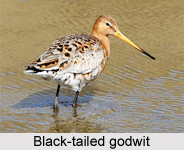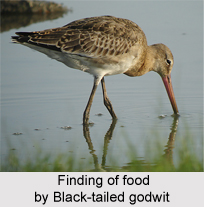 Black-Tailed Godwit is an Indian bird that bears a scientific name "Limosa limosa" and has the breeding plumage. This bird was first identified and described by Carolus Linnaeus in 1758.
Black-Tailed Godwit is an Indian bird that bears a scientific name "Limosa limosa" and has the breeding plumage. This bird was first identified and described by Carolus Linnaeus in 1758.
Structure of Black-Tailed Godwit
Black-Tailed Godwits are of three subspecies, all with orange head, neck and chest in breeding plumage and dull grey-brown winter coloration and distinctive black and white wingbar at all times.
Breeding Range of Black-Tailed Godwit
The breeding range of Black-Tailed Godwit stretches from Iceland through Europe and areas of central Asia. Black-Tailed Godwits spend winter in areas as diverse as the Indian Subcontinent, Australia, Western Europe and West Africa.
Breeding Places of Black-Tailed Godwit
Black-Tailed Godwit breeds in fens, lake edges, damp meadows, moor lands and bogs and uses estuaries, swamps and floods in winter. It is more likely to be found inland and on freshwater than the similar Bar-Tailed Godwit. The world population is estimated to be 634,000 to 805,000 birds and is classified as Near Threatened.
Bill of Black-Tailed Godwit
Black-Tailed Godwit is a large wader with long bill of 7.5 to 12 cm long, neck and legs. During the breeding season, the bill has a yellowish or orange-pink base and dark tip; the base is pink in winter.
Legs of Black-Tailed Godwit
The legs of Black-Tailed Godwit are dark grey, brown or black. The sexes are similar but in breeding plumage, they can be separated by the male`s brighter, more extensive orange breast, neck and head. In winter, adult black-tailed Godwits have a uniform brown-grey breast and upperparts (in contrast to the bar-tailed godwit`s streaked back). Juveniles have a pale orange wash to the neck and breast.
Black-Tailed Godwit in Flight
In flight, the bold black and white wingbar and white rump of Black-Tailed Godwit can be seen readily. When on the ground it can be difficult to separate from the similar Bar-Tailed Godwit, but the black-Tailed Godwit`s longer, straighter bill and longer legs are diagnostic. Black-Tailed Godwits are similar in body size and shape to bar-tailed, but stand taller.
Measurement of Black-Tailed Godwit
The measurement of Black-Tailed Godwit is 42 cm from bill to tail with a wingspan of 70-82 cm. Males weigh around 280 g and females 340 g. The female is around 5% larger than the male, with a bill 12-15% longer.
 Feeding of Black-Tailed Godwit
Feeding of Black-Tailed Godwit
In spring, black-tailed godwits feed largely in grasslands, moving to muddy estuaries after breeding and for winter. On African wintering grounds, swamps, floods and irrigated paddy fields can attract flocks of birds. In India, inland pools, lakes and marshes are used and occasionally brackish lakes, tidal creeks and estuaries.
Migration of Black-Tailed Godwit
Black-Tailed Godwit migrates from the Icelandic population winter mainly in the United Kingdom, Ireland, France and the Netherlands, though some fly on to Spain, Portugal and perhaps Morocco. Birds of the limosa subspecies in the family of Black-tailed godwit migrates from Western Europe fly south to Morocco and then on to Senegal and Guinea-Bissau. Birds from the eastern European populations migrate to Tunisia and Algeria, then on to Mali or Chad. The young Black-Tailed Godwits migrate from the European populations stay on in Africa after their first winter and return to Europe at two years old. Asian Black-Tailed Godwits winter in Australia, Taiwan, Philippines, Indonesia and Papua New Guinea.











